It was ugly early and often for Notre Dame against Cal. But with both lines finally controlling the game for solid stretches, the Irish carved out enough advantages against the Bears to pull away late. In Drew Pyne’s first start the ND offense was extremely careful but moved the ball well enough with short to medium runs and quick passes to put up points against Justin Wilcox’s defense. The Irish defense held a woeful Cal offense to inefficient performance, especially passing, but struggled with not-really-mobile QB Jack Plummer’s scrambles out of pressure.
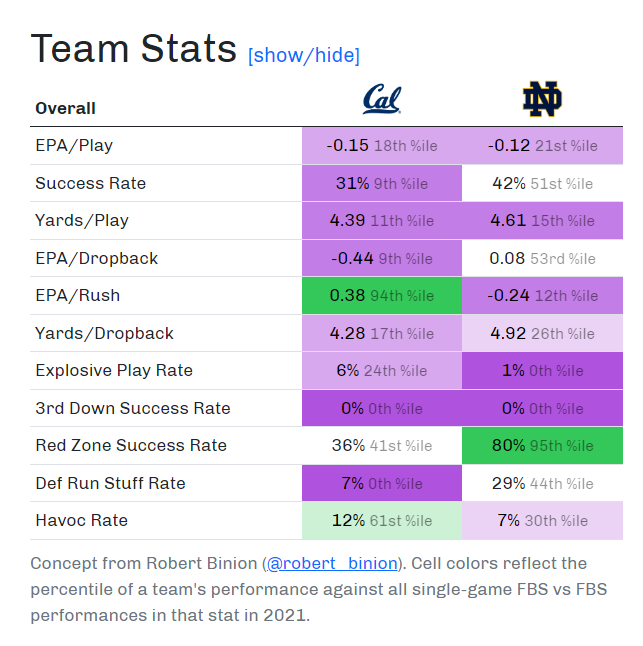
*Note: I’m not sure why the 3rd down success rate above didn’t compute, but Cal finished converting 26.7% of 3rd downs and Notre Dame 25%
This was a defensively-dominated game, one that we’d make fun of if the participants were Wisconsin and Iowa. The Irish ran the ball on 67% of early downs, rarely had Pyne attempt downfield throws, and averaged a little over four yards per carry in their best rushing game of the year. It wasn’t exactly a repeatable formula for success, but Notre Dame’s success in the trenches could be some light at the end of the early season tunnel.
Stats from a few excellent sources – College Football Data, Game On Paper, and often referencing SP+ and FEI numbers. If you get lost, check out this handy advanced stats glossary here or reach out in the comments.
The offense found just enough to scrape by – can more be unlocked?
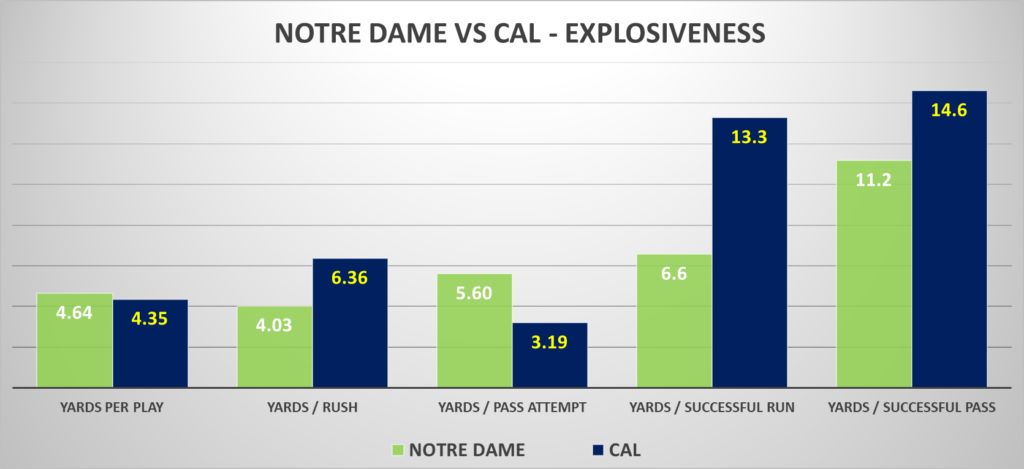
Going into this game Notre Dame fans seemed to fall into two camps, one sure that Pyne would be awful and doom the offense the rest of the season, and another optimistic he might spark the offense with some improved gameplans. Somehow both sides likely walked away feeling somewhat justified?
The “new-look” offense with Pyne under center went heavy on runs and short passes, minimizing the potential for turnovers (Cal had just one pass break-up) and intent on getting him comfortable. The plan to run on early downs and minimize 3rd and longs seems justified – the Irish had an average of 6.25 yards to gain on 3rd downs versus nearly 10 for Cal. Notre Dame didn’t convert any of the eight chances of 3rd and 5+ yards, and will need to show some signs of life on these obvious passing downs eventually.
Targets were distributed much more heavily to the running backs – 8 combined for Tyree and Estime versus just 10 for the wide receivers. A week after funneling the vast majority of passes toward Michael Mayer and Lorenzo Styles that tandem combined for just five catches on 10 attempts. The generous interpretation here is that Pyne managed to piece a few drives together despite not really being able to tap into his primary playmakers. Or if we go gloomier, will the offense under Pyne struggle to push the ball to those threats downfield moving forward?
The degree of difficulty is an important factor too – this is a Cal defense ranked 29th in FEI and 17th in SP+. Preseason projections are still being phased out, but the Golden Bears were arguably the second toughest defense left on the schedule after Ohio State (with Clemson the clear #1, and Syracuse trying to put together an argument).
Grinding out drives won’t last forever
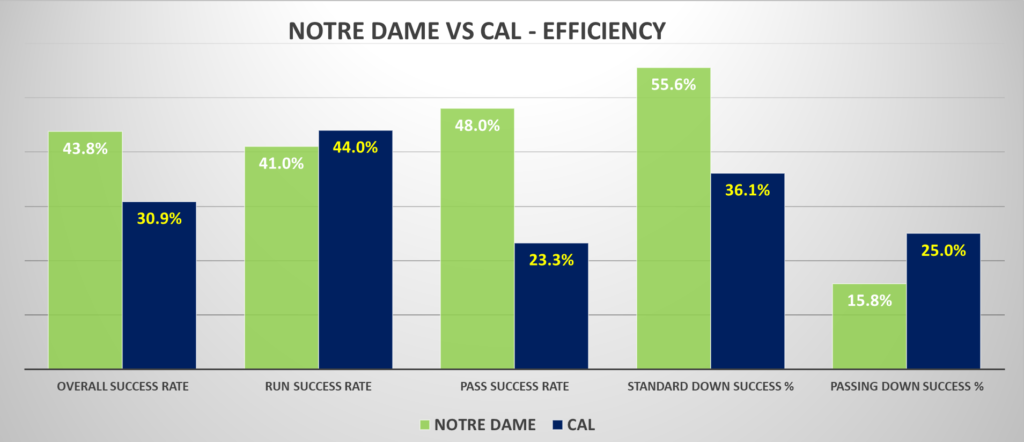
The lack of explosive plays, especially in the run game, meant that the degree of difficulty for the Notre Dame offense was high in terms of stringing together successful plays. The Irish were able to do this just well enough, avoiding passing downs on key drives and scoring points on each of the four scoring chances created. But these drives are hard to repeat without chunk plays – each of the ND scoring possessions was at least seven plays long, and two touchdown drives started with favorable field position (at the ND 40).

The offense can’t survive long-term with the formula of few explosive plays and poor performance on passing downs (currently 117th in passing down success rate). It may be a game-to-game calculation based on the opponent, but the offense needs to generate explosive plays by taking chances on standard downs (more favorable) or converting passing downs (higher risk). Does Rees trust Pyne to do either of these things and can Pyne do this without turning it over? The answer will go a long way in determining how much the offense can steady itself.
Speaking of Tommy, the discourse around the once beloved OC has gone full First Take. Is Tommy overrated? Does he stink now? Is he on the hot seat? This feels like a wild overreaction to Rees lovers and haters each building up straw men to argue against. The beginning of this season has been fairly brutal, but it seems like a lot of criticism is untethered from the reality of past performance and what’s on the current roster.
Let’s start with the past – in his first two seasons as offensive coordinator, Rees fielded top-20 offenses (the advanced stats dislike 2020 more than I do, but let’s go conservative here). That’s very solid work, as the personnel in each year featured:
- 2020: veteran Ian Book, a terrific OL, RB, and TE play, but a dearth of WR talent (especially the explosive kind)
- 2021: an offensive line that was one of the worst P5 units in the first half, inconsistent WR play, same great RB and TE guys, and an above average QB but not a run threat or great under pressure
The weakness that’s now a clear trend is how well Rees prepares for the start of each year with new personnel and how quickly he can adapt. But once again in 2022 he’s handicapped quite a bit – initially by a paper-thin WR depth chart, that if it features any NFL talent is a year or two away, by an OL underperforming expectations, and now with a QB where average P5 starter play would be a massive win. Rees at this point in his career is probably a B-level coordinator with high potential, but it’s becoming increasingly harder to see the Notre Dame marriage lasting long. Either Freeman will need an A-level guy sooner rather than later, or Rees will start developing further into that guy and leaving for a potential upgrade.
A timely defensive effort with spots to shore up
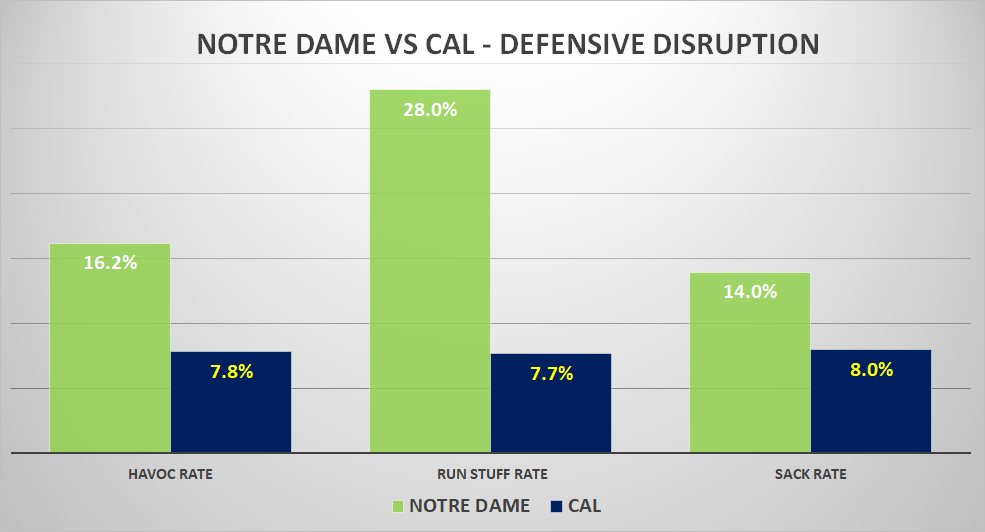
It’s hard to be too critical of a defensive effort that includes six sacks, holding Cal to just 4.3 yards per play, and poor efficiency. The Irish pass rush and defensive disruption arrived for the first time this season and could have tallied even more sacks on Plummer. The Golden Bears drop-back passes and rushes by backs were largely held in check all day. The one weak point was the Irish defense giving up 80 rushing yards to Plummer, again not known for his legs. This would set off fewer alarm bells on its own, but this was a recurring issue for Notre Dame in several games last year (notably Virginia Tech and UNC).
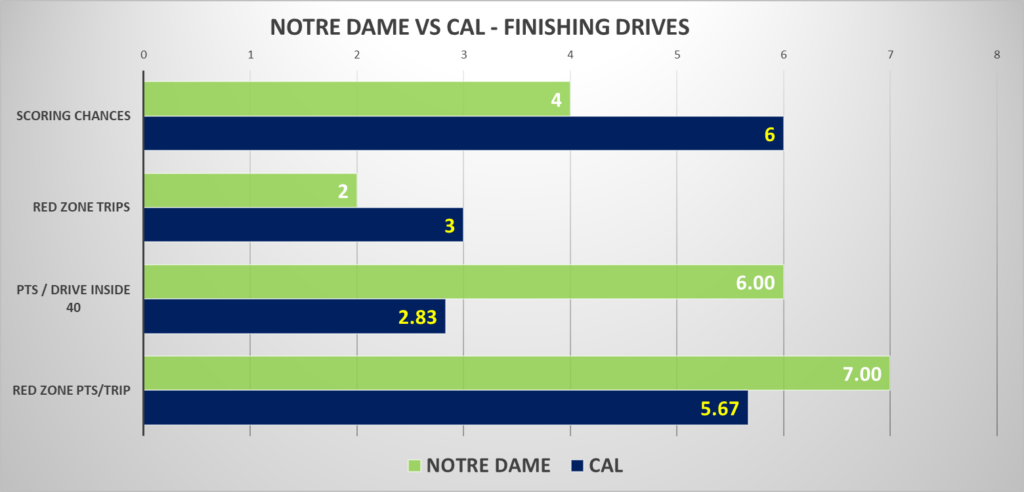
Just a few small slipups – Plummer escaping for costly scrambles, dumb penalties extending drives, a fumbled snap gifting field position – led to Cal scoring chances. Again the Irish were very good at minimizing points off scoring opportunities, forcing stops for field goal attempts, and stymieing two late scoring drives to tie the game.
“The turnovers will come” is becoming a familiar refrain for the defense, but it ignores that Notre Dame isn’t creating that many chances to take the ball away. The uptick in sacks is a good sign, but the Irish are one of only 11 FBS teams yet to force a fumble this fall, and rank 126th in pass break-ups per game.

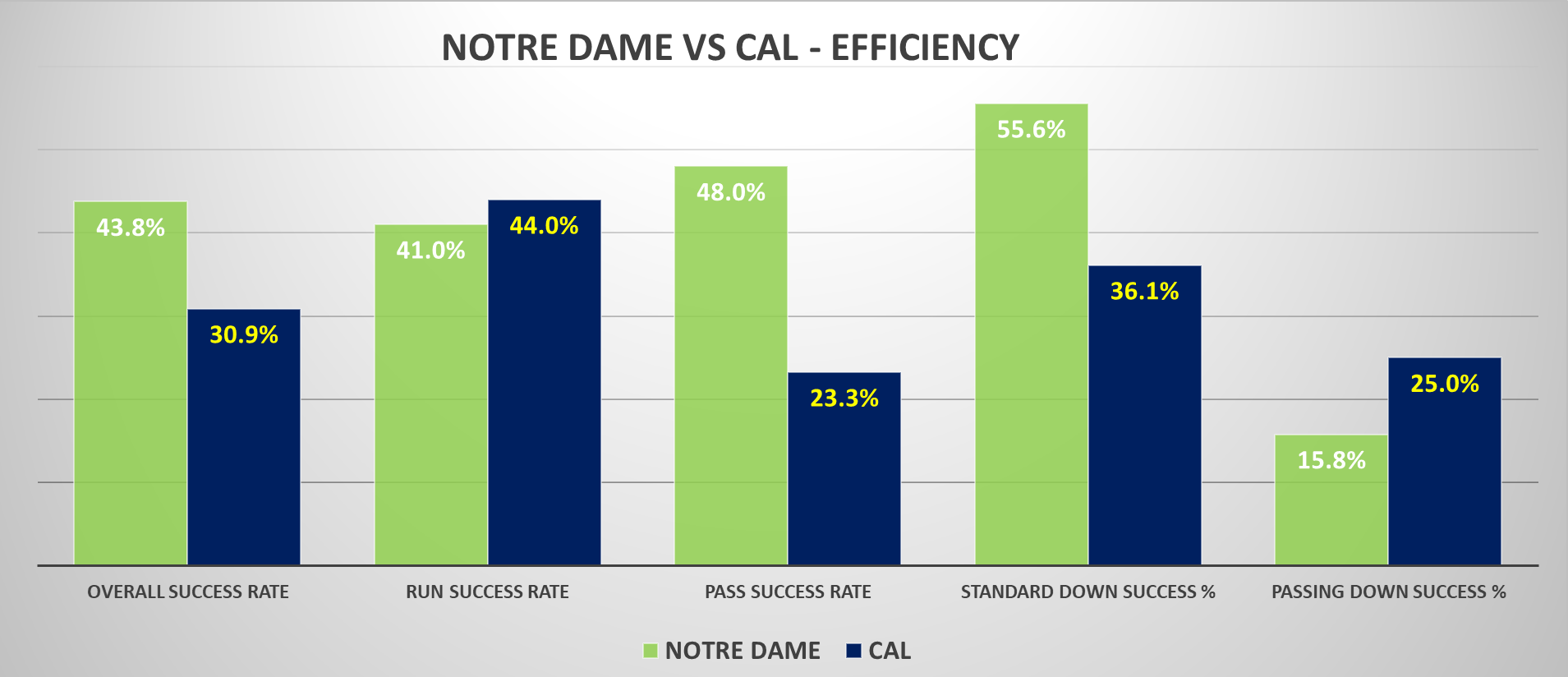



Rees’s biggest weakness so far seems to be recruiting/evaluating QBs. That he’s handicapped by the talent is partially his fault. It’s hard to know exactly what all the other limiting factors were (Del, Kelly) but missing out on an elite QB in 2023 might be his downfall. It’s hard to be great without top-end talent. The only way Rees will last much longer I suspect is if they get a grad-transfer that turns out really well for 2023 and maybe even another one for 2024 until Carr is ready to take over (assuming he ends up coming to ND).
It hasn’t been great, I think the QB evaluation process is kind of a crapshoot but ND certainly hasn’t had many dice roll come up on the right side. It’s still premature to dismiss Buchner IMO but picking him over McCarthy looks very bad at the moment.
It’s been discussed at length but it’s really hard to win the battles for the top-end talent without proof of concept first (putting great passing offense on the field, guys into high draft picks). A huge criteria for every top guy is “how well will I be set up for pro success”, and Tommy / the ND offense’s case right now is not close to the top 10.
I certainly agree it is a crapshoot. When you go back and look at the top 10 QBs every year there seem to be a lot of guys that are misses (like 1st/2nd round NFL QBs).
Even during the Book era proof of concept was a big problem?
Either way, I suppose that’s where you need to be able to take that lower-rated player and turn him into a QB good enough to run whatever is good enough to get those top-end QBs.
I think part of the long-term problem with QB recruiting is that we haven’t had a consistent offensive identity since, well, Charlie Weis. Kelly recruited a wide range of QBs in terms of style and build (although he certainly tended toward smaller QBs), then tried to fit the offense to whoever the hot hand was. In 2017, we were an extremely run-heavy Super Navy with Wimbush. Then in 2018, we were almost a West Coast Offense with Book. After Book, we switched to an old NFL-style pocket passer in Coan, then back to a small running QB in Buchner, and now onto Pyne.
So I think top QBs look at ND and think, “Who the hell knows what they’ll be running by the time I’m a starter, or even next year?”
Even if the OL is stabilized and plays well figuring out this ^^^^ remains the key to the season.
I’m hopeful that if Pyne can settle in a bit, the OL continues to pass protect like they did against Cal, and if Colzie, Merriweather, and Wilkins can come in and provide a bit of a presence on the boundary that maybe we could get marginally better in this area.
Other than to Salerno against OSU have we even thrown anything resembling a back shoulder fade to the boundary? We have thrown a couple of slot fades with decent success but we are getting like zero production out of the boundary it seems.
If we can’t fix the receivers it’s getting to be time to release the Raridon.
4 snaps vs Cal, 4 new bruises on the Cal OLB. Let him run a route.